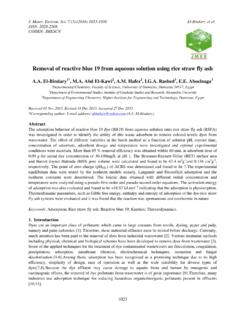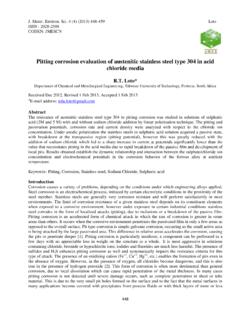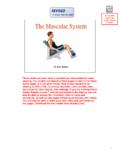Transcription of Thermal Conductivity Characterization of Bamboo Fiber ...
1 J. Mater. Environ. Sci. 3 (6) (2012) 1109-1116 Mounika et al. ISSN : 2028-2508. CODEN: JMESCN. Thermal Conductivity Characterization of Bamboo Fiber Reinforced Polyester Composite M. Mounika1,*, K. Ramaniah2, Ratna Prasad2, K. Mohana Rao2, K. Hema Chandra Reddy3. 1. Student, Department of Mechanical Engineering, V R Siddhartha Engineering College, Vijayawada-520 007, India 2. Department of Mechanical Engineering, V R Siddhartha Engineering College, Vijayawada-520 007, India 3. JNT University Anantapur, Anantapur-521501, India Received 04 July 2012, Revised 15 July 2012, Accepted 15 July 2012. * Corresponding Author details: Tel: 09030067779. Abstract The main focus of this study is on Thermal Conductivity Characterization of Bamboo Fiber reinforced composite by varying volume fraction, temperature and Fiber angles (00, 450 and 900). Bamboo fibers are extracted from its stem using retting and mechanical extraction procedure. These extracted fibers are used as reinforcement in polyester resin matrix for making partially green biodegradable material composite via hand lay-up technique.
2 The Thermal Conductivity Characterization of composites is investigated experimentally by a guarded heat flow meter method. The results show that the Thermal Conductivity of composite decreases with increase in Fiber content and quite opposite trend was observed with respect to temperature. Moreover, the experimental results of composites at different volume fractions were compared with two different theoretical models (E-S Model and Rule of Mixture Model). Good agreement between theoretical and experimental results has been observed. On the other hand, the variation in Thermal Conductivity with respect to Fiber orientation also showed significant effect on Thermal Conductivity . Thermal conductivities of Bamboo Fiber reinforced composite at maximum volume fractions are , and for Fiber angles of 00, 450 and 900 respectively. The results of this study indicate that the developed composite is an insulating material. Therefore, this composite can be used in building and automotive industry to save energy by reducing rate of heat transfer.
3 Keywords: Bamboo , Thermal Conductivity , Fiber orientation, guarded heat flow meter. 1. Introduction: Natural Fiber as a replacement to synthetic Fiber in polymer matrix is the focus of many scientists and engineers. The reason for focus on natural Fiber reinforced polymer matrix is because of its low cost, low effect on environment and also it shows good mechanical properties compared to polymer resins. Natural Fiber reinforced composites are advantageous over the metals when excellent corrosion resistance is required. Apart from mechanical properties, Thermal properties are also required for specific applications [1-3]. 1109. J. Mater. Environ. Sci. 3 (6) (2012) 1109-1116 Mounika et al. ISSN : 2028-2508. CODEN: JMESCN. Tests on mechanical properties of natural Fiber reinforced composites were extensively done by many investigators. The tensile properties of sisal, hemp, coir, kenaf and jute reinforced composites have been studied, and reported that among all the composites, hemp reinforced composite exhibited the highest mechanical properties whereas the coir showed the lowest [4].
4 Symington et al. studied the effect of moisture content on tensile properties of natural fibers: jute, kenaf, flax, abaca, sisal, hemp and coir and concluded that jute Fiber exhibited better mechanical properties than other fibers [5].Work is also done on the investigation of mechanical properties of Bamboo Fiber reinforced polymer composite. The experimental results of ultimate tensile strength and tensile modulus are and , while the ultimate flexural strength and flexural strength are and respectively [6]. Sherely Annie Paul et al. worked on the periodical method, to estimate the Thermal Conductivity , Thermal diffusivity of polypropylene (PP)/banana Fiber commingled composites at room temperature. It was found that the Thermal Conductivity and Thermal diffusivity of the composites decrease with Fiber loading [7]. The Thermal Conductivity , Thermal diffusivity, and specific heat of flax Fiber high density polyethylene (HDPE). bio composites were determined in the temperature range of 1700 2000C using the line-source technique.
5 Thermal Conductivity and Thermal diffusivity did not change significantly with temperature in the range studied whereas specific heat and density of the bio composites increased gradually with temperature [8]. G. Kalaprasad worked on the Thermal Conductivity and Thermal diffusivity of sisal-reinforced polyethylene (SRP), glass-reinforced polyethylene (GRP) and sisal/glass hybrid fibre-reinforced polyethylene (GSRP) from at cryogenic to high temperature (120 350 K). They concluded that the Thermal Conductivity increased with temperature and leveled off afterwards [12]. Thermal Conductivity of composite is anisotropic property similar to elastic modulus [9]. Some theoretical and empirical models have been developed to predict the Thermal Conductivity of composites [10-14]. Heat flow meter [15] or the transient plane source method [15] was used to measure the Thermal Conductivity of polymer composites. Extensive research has been carried out on synthetic Fiber reinforced polymer composites.
6 But little information is available on thermo physical properties of natural Fiber reinforced composites over and above room temperature [16-20]. Thermal Conductivity Characterization of Fiber Reinforced Polymer (FRP) composites is also done in three directions (longitudinal, transverse and through-the-thickness). Results showed that E-glass/Vinyl ester samples have a Thermal Conductivity of W/ m K, while the Conductivity of carbon composites is higher in the Fiber direction and lower in through-the-thickness direction. Addition of 10 wt% and wt% of graphite additive in neat vinyl ester resin increased the Conductivity by 88% and 170% respectively. The overall trend shows that Conductivity of E-glass/Vinyl ester composite is in the range. Carbon/Vinyl ester composite has a Thermal Conductivity in longitudinal direction being almost twice the Conductivity in transverse and four times greater than through-the-thickness direction [21]. Bamboo is a type of grass (Scientific name: Bambuseae) and is among the fastest growing plants on the planet.
7 One Japanese species rockets skywards at a rate of a meter a day. Some bamboos can reach a lofty 35metres in height while others are only half a meter tall. It is economically important to humans as a building material. There are 1,500 different species of Bamboo . Extensive work has been carried out on natural Fiber reinforced composites and when compared to the research on mechanical properties of natural Fiber composites, the analysis and evaluation of Thermal properties is also left a step behind. Therefore the focus of the work is to investigate the Thermal properties of composite by considering some natural fibers which are not explored so far. In that aspect the Thermal Conductivity Characterization of Bamboo Fiber reinforced polyester composite is investigated. Thermal Conductivity is investigated as a function of Fiber volume fraction, temperature and Fiber orientation. 2. Materials and Methods Materials Unsaturated polyester resin of grade ECMALON 4411, methyl ethyl ketone peroxide and cobalt naphthanate were purchased from Ecmass resin (Pvt) Ltd.
8 , Hyderabad, India. 1110. J. Mater. Environ. Sci. 3 (6) (2012) 1109-1116 Mounika et al. ISSN : 2028-2508. CODEN: JMESCN. Fiber extraction A process called retting is employed to extract Fiber from plant process involves the action of bacteria and moisture on dried Bamboo strips to dissolve and rot away cellular tissues and gummy substances that surround the Fiber bundles in the strips. And this soaking process loosens the fibers and can be extracted out easily. Finally, the fibers were washed again with water and dried at room temperature for about 5 days. Preparation of composite Composites are prepared as per the ASTM E-1530 standards. The foremost required resin mixture is prepared by adding accelerator and catalyst to resin at room temperature for curing which was by volume of resin. The samples were prepared using Hand lay-up technique. Hand lay-up technique was adopted to fill up the prepared mold with an appropriate amount of polyester resin mixture and unidirectional fibers, starting and ending with layers of resin.
9 Fiber deformation and movement should be minimized to yield good quality, unidirectional Fiber composites. Therefore at the time of curing, a compressive pressure of was applied on the mold and the composite specimens were cured for 24 h. The specimens were also post cured at 700C for 2 h after removing from the mold. Thermal Conductivity measurement Thermal Conductivity of the composites as a function of volume fraction, temperature and Fiber orientation (Fig. 1) was measured using guarded heat flow meter (Unitherm model 2022, ANTER Corp., Pittsburgh, PA). Fig. 1: Representation of heat flow while changing the Fiber orientation. In accordance with ASTME1530 99 [22], the test sample of size 50 mm in diameter and 10 mm in thickness were prepared. Following equations (1-3) correspond to the calculation of Thermal Conductivity [23, 24]: (1). (2). (2). (3). (3). Where q is the heat flux (Wm-2), k is the Thermal Conductivity (Wm-1 K-1), T1-T2 is the difference in temperature (K), L is the thickness of the sample (m), and R is the Thermal resistance of sample (m2KW-1).
10 1111. J. Mater. Environ. Sci. 3 (6) (2012) 1109-1116 Mounika et al. ISSN : 2028-2508. CODEN: JMESCN. 3. Results and discussion Measurement of Thermalconductivity Thermal Conductivity of Bamboo Fiber reinforced composites with different Fiber loadings are presented in Table results show that Thermal Conductivity of composites decreases as Fiber content increases. The Thermal Conductivity of Fiber and matrix have been evaluated by extrapolating the linear regression of Thermal Conductivity values of the composite to 100% Fiber and 0% Fiber and are found be and respectively. The behavior of the Thermal Conductivity of different composites can now be explained using Thermal Conductivity values of the Fiber . Further, the measured Thermal Conductivity of composites was compared with series model (Rule of mixture) and E-S expressions for these two models are: Series model: 1 vf (1 vf ).. kc kf km (4). E-S model: Ke . kc 1 . 1 . c ln d d 2. c2 . km c 2d d d 2.






